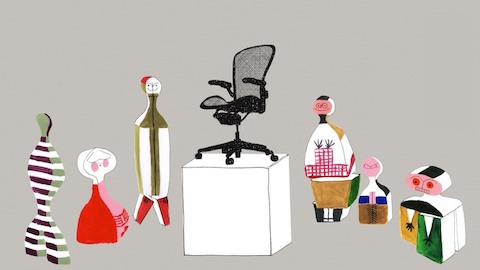In the early 1970s, as systems furniture and especially Herman Miller’s innovative Action Office were catching on, the company needed a manufacturing facility in the U.K. to serve the European market. Max De Pree, son of Herman Miller founder D.J. De Pree, took charge of selecting an architect and leading the project. He had begun to learn about architecture in the previous decade from the likes of George Nelson and Gordon Chadwick. And his family’s house in Zeeland, Michigan, built in 1954, had been designed by Charles Eames.
Max was a thoughtful businessman. His father had founded Herman Miller in 1923. He and his brother Hugh had joined the company after serving in the armed forces during World War II. These three men held definite views about their business: a respect for design, a belief in the innate worth of every individual, and a commitment to share risks and rewards with all employees. Their egalitarian beliefs heavily influenced the design of Herman Miller and Max’s thinking about the new building. The De Prees were not afraid of innovation.
Max wrote a “Statement of Expectations” as the brief for the new building in Bath, England. He and his team interviewed three architects. One admitted that almost all of his buildings leaked. One threatened never to specify Herman Miller products if not chosen. One connected immediately. Nick Grimshaw and Farrell/Grimshaw Partnership in London won the job. Grimshaw was not then the starchitect he has since become, and both he and Max felt a “chemistry,” as Max said later in an article in the Herman Miller publication Ideas (January, 1979). Grimshaw said in his response to the brief, “Many of the views expressed about the well-being of the users, flexibility, and non-monumentality agree very closely with the approach we have built up since the founding of our practice ten years ago. We feel particularly that any new building should not impose itself on the occupiers, but that it should be a tool in their hands.”

Spreads from Idea magazine, January 1969, and Icon magazine, May 2014.
At one point, Grimshaw took Max up to a hill overlooking the site and the city of Bath. Max remembers Grimshaw warning him not to foul up this wonderful city. On another occasion, Grimshaw told Max that even though Herman Miller owned the property along the river, they didn’t own the river. Everyone who lived in Bath had the right to enjoy it. That’s why, says Max, we never minded the fishermen using the chairs we kept outside the building on the riverbank.
Grimshaw and his team were immensely impressed and inspired by the “Statement of Expectations.” They took photographs of the completed building—it opened in 1976—illustrating each of Max’s statements with an image. The combination was printed in a charming, now out-of-print booklet published by Herman Miller, which is reproduced below.
The statements make for a good checklist for almost any building and without too much of a stretch for any design project. They are broad, philosophical guidelines that reflect the De Prees’ belief that the company should make itself “vulnerable” to the ideas of creative designers such as Nelson, Charles and Ray Eames, and Alexander Girard. They focus on people and human activity, not on making a visual or theoretical statement. They emphasize the good of the community, not the achievement of a single person. As De Pree saw it, “It is possible to say that our aim is to build the indeterminate building.”
“We can’t foul up this wonderful city... You may own the property along the river, but you don’t own the river. Everyone who lives here has the right to enjoy that. ”
-Nicholas Grimshaw











As Max says, “We didn’t have any budget for marketing, and we needed the building to win lots of prizes and generate attention.” And so it did, winning among other awards the important Financial Times Industrial Architecture Award for 1977. The judges called the building, “a fine example of brilliant architecture skill, industrial engineering, and management imagination.”
Among the nearly 55,000 square foot building’s remarkable innovations: a hanging walkway containing utilities to allow for change in manufacturing layout; reconfigurable courtyards for employee break periods; modular bathrooms that could be moved to any location in the building; plastic, demountable panels on the exterior of the building to allow for change or expansion. According to Jeff Scherer, a young American architect who worked with Grimshaw as a project lead, Max looked at the building as “one in a long series of actions over the long term.” It had to adapt to its ever-changing context.
In 2011, Herman Miller solicited bids to construct a new building to combine both manufacturing and office space near Chippenham, the Bath building having become outdated and unsuitable after almost 40 years of productive life. The leaders of the project, fearing the small budget would insult Grimshaw, did not ask him to bid.
Purely by coincidence at the same time, an intern in Grimshaw’s office had put together a retrospective of the architect’s work, including Herman Miller’s Bath building. Curious to see how the building was faring, Grimshaw called Herman Miller to arrange a tour. Andy Lock, President of Herman Miller International, met Grimshaw in Bath, bothered by the knowledge that the building was soon to be sold and a new one constructed.
The next day, having decided truth should be told, Lock called Grimshaw. The architect asked why he had not been included in the bidding. When told the answer, he insisted on designing the new building, despite the limited budget.
Sir Nicholas Grimshaw CBE, PRA, RIBA, AIA thinking back to the Bath Brief, decided to write a new chapter in the architecture of a 109-year-old design company. The new building is under construction and is scheduled to open next year.
“Max looked at the building as ‘one in a long series of actions over the long term.’ It had to adapt to its ever-changing context.”



